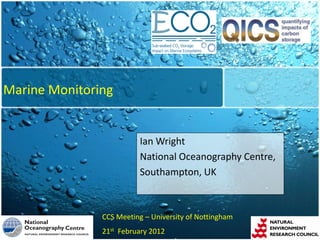
Wright nott
- 1. Marine Monitoring Ian Wright National Oceanography Centre, Southampton, UK CCS Meeting – University of Nottingham 21st February 2012
- 2. Presentation Outline • Storage site characteristics and monitoring strategy; • Leakage scenarios and temporal sequence of emission; • Current monitoring state of art; • Marine monitoring for CO2 volume loss - challenges; • Conclusions
- 3. CCS Storage Sites EOR Sites Saline Aquifers Sites • ~ 250 km2 reservoir / • ~22500 km2 reservoir / seafloor area; seafloor area; • ~25-30 km3 ocean; • ~2500-3000 km3 ocean; • point > dispersed seep • point = dispersed seep sources. sources.
- 4. CCS Leakage Scenarios A continuum from: • High discharge (e.g., >200 tonnes d-1) point source leakage (due to acute well-casing leakage or hydro-fracturing of a seal cap) in a relatively small depleted reservoir site, • Low discharge (e.g., <20 tonnes d-1), dispersed source discharges from an extensive saline aquifer system. • Necessitates diverse, and responsively staged monitoring. + Transport + Storage + Leakage Assurance CCS Capture + Monitoring = Implementation Impact
- 5. Monitoring strategies How do we monitor sites 250 - 22500 km2 in area, with ocean volume of 25 - 2500 km3, with potentially known and unknown point and dispersed seep sources? • Baseline monitoring; • Seafloor / ocean leakage detection; • Quantification of CO2 leakage. Point source, high discharge dispersed, low discharge leakage
- 6. Deep geophysical detection Current regulatory monitoring practice places significant emphasis on “deep” geophysical monitoring of reservoir formation, integrity of the capping seal, and migration of CO2 within the reservoir.
- 7. 4-D Geophysical monitoring of Sleipner from Geophysical monitoring of CO2 storage 4-D MCS has been very successfulet al., 2003 Chadwick Very clear imaging and modelling of CO2 accumulation and expansion of “gas plume” within the reservoir. Kaarstad, 2004 1996 1999 2001
- 8. Deep geophysical detection Requires known quantitative relationship between any geophysical parameter and supercritical CO2, but probably not sensitive enough for regulation and carbon emission trading.
- 9. Seafloor detection -1 Two additional significant opportunities for CCS monitoring: 1. Probable that pre-cursory fluids will be emitted at the seafloor before CO2 due to buoyancy pressure of CO2 displacing stratigraphically higher fluids. 2. Seafloor, and lesser extent the overlying ocean, provide a site for more direct and quantitatively explicit measurement of CO2 flux (both as free gas and dissolved phases) that is potentially more sensitive for measurement and verification of CO2 leakage.
- 10. Leak Detection Signature of seeping fluids on to seafloor and overlying water-column Reduced unconsolidated sediment pore fluids; • Increase Fe, [Fe (II)], Mn • Increase H2S • Decrease Eh Reservoir formation fluids / brines; • Increase salinity • Increase temperature • Increase noble / inert gases (e.g., radon, neon, argon) CO2 fluids, free gas, dissolved phase • Increase CO2 (dissolved phase ± free gas) • Decrease pH • ?Increase trace / heavy metals
- 11. Seafloor detection - 2 Physical and chemical signatures of CO2 loss from the seafloor, either as direct CO2 measurement, a decrease in pH, or emission of gas bubbles, are arguably more tractable both in the sense of making the observation and understanding its relationship to CO2 volume loss.
- 12. Seafloor physical detection Physical techniques developing around passive and active acoustic bubble detection that would determine free gas leakage. Hydrophones acoustically detect bubble oscillation and expansion, while active sonar record the acoustic back-scatter response of ascending gas bubbles. Multi-frequency acoustic data can be inverted to determine bubble size populations.
- 13. Seafloor chemical detection Chemical techniques could include elevated salinity, Mn, ferrous Fe, acidity, H2S, and lower dissolved oxygen. Typical LOD’s for dissolved Fe and Mn are nM, methane 0.2 nM, salinity 0.00001, temperature 0.005°C, and for pH is currently 0.005-0.003 pH unit, but could be improved to 0.0005 pH unit in the near future. Similarly, a CO2 sensor with a detection limit of ~3 ppm is possible using microfluidic techniques.
- 15. Monitoring platforms Temperature Salinity Turbidity Dissolved oxygen MBARI
- 16. Conclusions (1) • CCS sites with both large spatial seafloor extent and overlying ocean volumes (with potentially dispersed and localised emission sources) provide a monitoring challenge; • Essential rationale for monitoring will be baseline studies, leakage detection, and flux emission quantification; • Potential CO2 leakage will have precursor fluid release of reducing sediment pore fluids ± aquifer brines (each of which has a unique chemical signature); • New marine sensor and underwater platform technology is developing to deploy long-term point observing and remotely surveyed monitoring of the critical fluid parameters at the necessary sensitivity and spatial scales for CCS sites (and at relative low cost);
- 17. Conclusions (2) • Monitoring can comprise “deep” remote passive / active geophysical imaging and direct measurement of dissolved & free gas emissions at seafloor / ocean. • The former is deployable now but will require inversion of applicable geophysical parameters to CO2 flux loss; • The latter is not yet deployable but will directly measure emission fluid fluxes (including precursory fluids) but requires more baseline knowledge; • The regulatory framework emphasises monitoring of the reservoir, but if leakage occurs, then quantification of CO2 loss is probably easier and more accurate at the seafloor.
